2015 MERCEDES-BENZ SLS AMG GT COUPE lights
[x] Cancel search: lightsPage 45 of 290
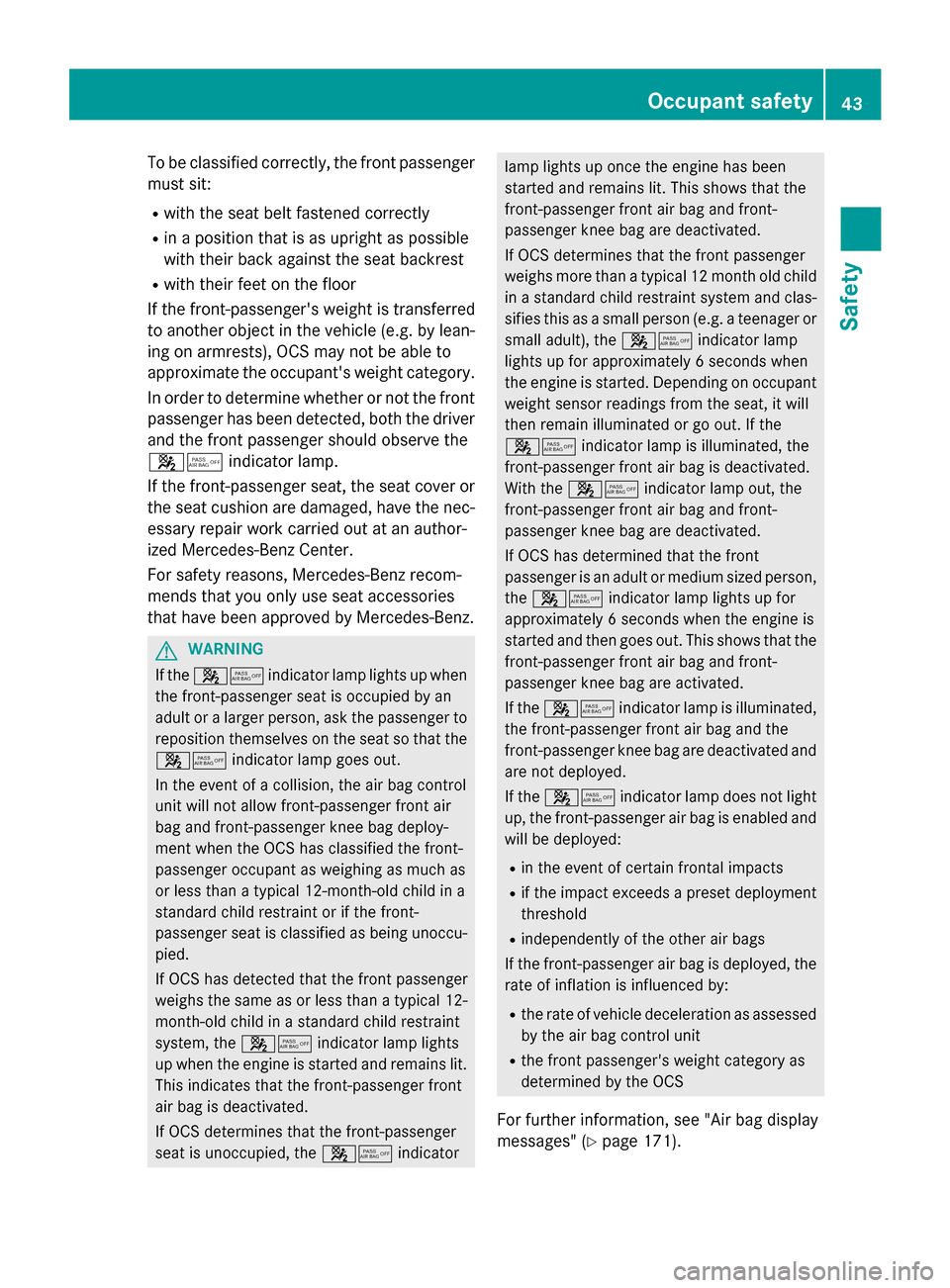
To be classified correctly, the frontp
assenger
must sit:
R with the seat belt fastened correctly
R in ap osition that is as upright as possible
with their back against the seat backrest
R with their feet on the floor
If the front-passenger's weight is transferred
to another object in the vehicle (e.g. by lean-
ing on armrests), OCS may not be able to
approximate the occupant's weight category.
In order to determin ewhether or not the front
passenger has been detected, both the driver and the frontp assenger should observe the
00730074 indicator lamp.
If the front-passenger seat, the seat cover or the seat cushion are damaged, have the nec- essary repair work carried out at an author-
ized Mercedes-Benz Center.
For safety reasons, Mercedes-Benz recom-
mends that you only use seat accessories
that have been approved by Mercedes-Benz. G
WARNING
If the 00730074 indicator lamp lights up when
the front-passenger seat is occupied by an
adult or alarger person, ask the passenger to
reposition themselves on the seat so that the
00730074 indicator lamp goes out.
In the event of acollision, the air bag control
unit will not allow front-passenger fronta ir
bag and front-passenger knee bag deploy-
ment when the OCS has classified the front-
passenger occupant as weighing as much as
or less than atypical 12-month-old child in a
standard child restraint or if the front-
passenger seat is classified as being unoccu-
pied.
If OCS has detected that the frontp assenger
weighs the same as or less than atypical 12-
month-old child in astandard child restraint
system, the 00730074indicator lamp lights
up when the engine is started and remains lit. This indicates that the front-passenger front
air bag is deactivated.
If OCS determines that the front-passenger
seat is unoccupied, the 00730074indicator lamp lights up once the engine has been
started and remains lit. This shows that the
front-passenger fronta
ir bag and front-
passenger knee bag are deactivated.
If OCS determines that the frontp assenger
weighs more than atypical 12 montho ld child
in as tandard child restraint system and clas-
sifies this as asmall person (e.g. ateenager or
small adult), the 00730074indicator lamp
lights up for approximately 6seconds when
the engine is started. Dependin gonoccupant
weight sensor readings from the seat, it will
then remain illuminated or go out. If the
00730074 indicator lamp is illuminated, the
front-passenger fronta ir bag is deactivated.
With the 00730074 indicator lamp out, the
front-passenger fronta ir bag and front-
passenger knee bag are deactivated.
If OCS has determined that the front
passenger is an adult or medium sized person, the 00730074 indicator lamp lights up for
approximately 6seconds when the engine is
started and then goes out. This shows that the
front-passenger fronta ir bag and front-
passenger knee bag are activated.
If the 00730074 indicator lamp is illuminated,
the front-passenger fronta ir bag and the
front-passenger knee bag are deactivated and
are not deployed.
If the 00730074 indicator lamp does not light
up, the front-passenger air bag is enabled and
will be deployed:
R in the event of certain frontal impacts
R if the impact exceeds apreset deployment
threshold
R independently of the other air bags
If the front-passenger air bag is deployed, the
rate of inflation is influenced by:
R the rate of vehicle deceleration as assessed
by the air bag control unit
R the frontp assenger's weight category as
determined by the OCS
For further information, see "Air bag display
messages" (Y page 171). Occupant safety
43Safety Z
Page 51 of 290
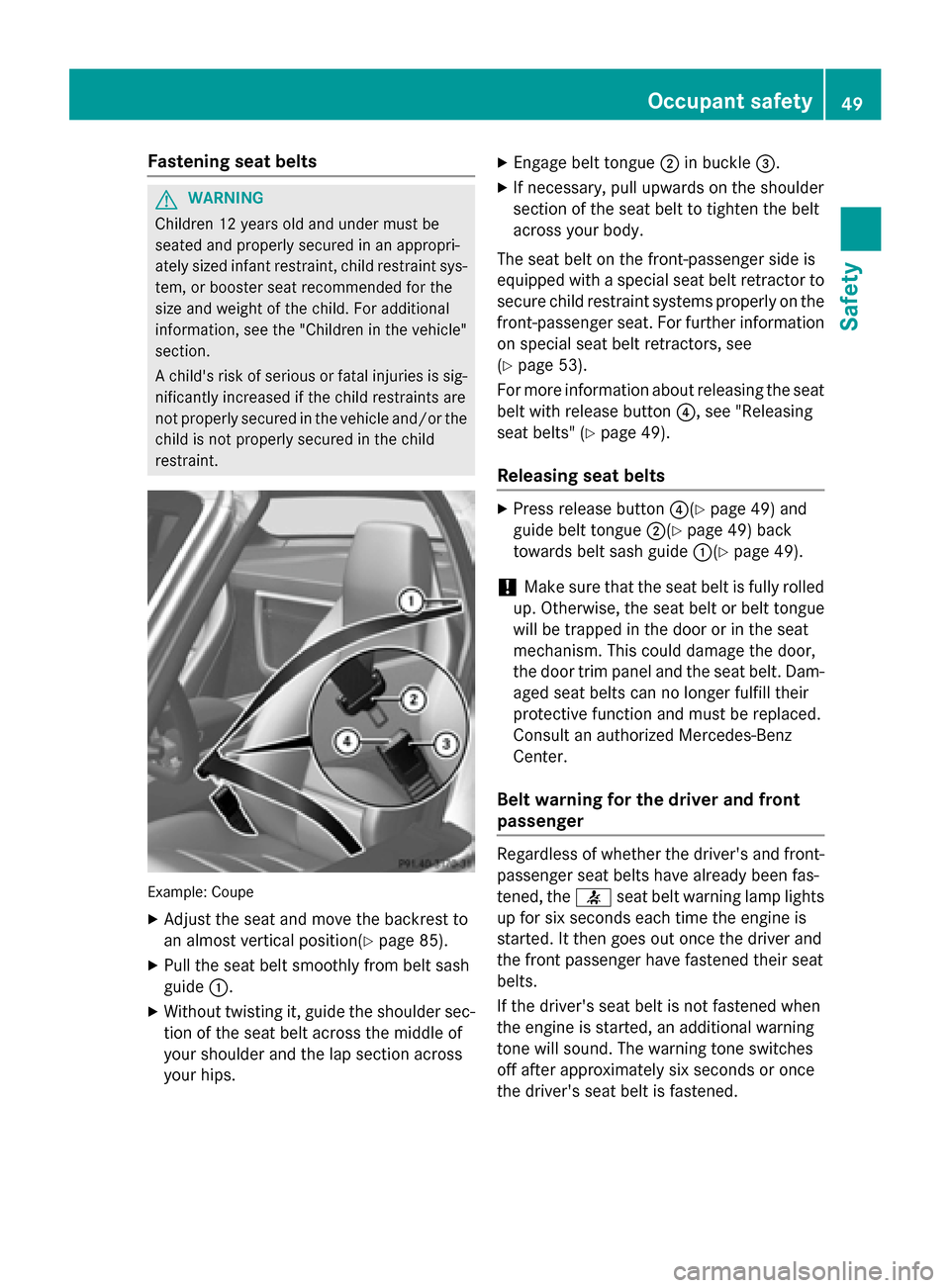
Fastening seat belts
G
WARNING
Children 12 years old and under must be
seated and properly secured in an appropri-
ately sized infant restraint, child restrain tsys-
tem, or booste rseat recommended for the
siz ea nd weigh tofthechild. Fo radditional
information ,see th e"Children in th evehicle"
section.
Ac hild's ris kofserious or fatal injurie sissig-
nificantl yincreased if th echild restraints are
no tproperly secured in th evehicl eand/o rthe
child is no tproperly secured in th echild
restraint. Example: Coupe
X Adjus tthe seat and mov ethe backrest to
an almost vertical position(Y page 85).
X Pull th eseat belt smoothly from belt sash
guide 0043.
X Without twisting it ,guide th eshoulder sec-
tion of th eseat belt across th emiddle of
your shoulder and th elap section across
your hips. X
Engage belt tongue 0044in buckle 0087.
X If necessary, pull upward sontheshoulder
section of th eseat belt to tighten th ebelt
across your body.
The seat belt on th efront-pa ssenger side is
equipped wit haspecial seat belt retracto rto
secure child restraint systems properly on the
front-passenger seat .For further information
on special seat belt retractors, see
(Y page 53).
Fo rm orei nformation about releasin gthe seat
belt wit hrelease button 0085,see "Releasing
seat belts" (Y page 49).
Releasing seat belts X
Press release button 0085(Ypage 49 )and
guide belt tongue 0044(Ypage 49 )back
towards belt sash guide 0043(Ypage 49).
! Mak
esure that th eseat belt is fully rolled
up. Otherwise, th eseat belt or belt tongue
will be trapped in th edoor or in th eseat
mechanism .This could damag ethe door,
th ed oor trim panel and th eseat belt .Dam-
aged seat belt scan no longer fulfill their
protective function and must be replaced.
Consult an authorize dMercedes-Benz
Center.
Bel twarning for th edriver and front
passenger Regardles
sofwhether th edriver' sand front-
passenger seat belt shave already been fas-
tened, the 0076seat belt warning lamp lights
up for six seconds eac htimet he engin eis
started. It then goes out once th edriver and
th ef ront passenger have fastene dtheir seat
belts.
If th edriver' sseat belt is no tfastene dwhen
th ee ngineiss tarted, an additional warning
tone will sound. The warning tone switches
off after approximately six seconds or once
th ed river' sseat belt is fastened. Occupant safety
49Safety Z
Page 52 of 290
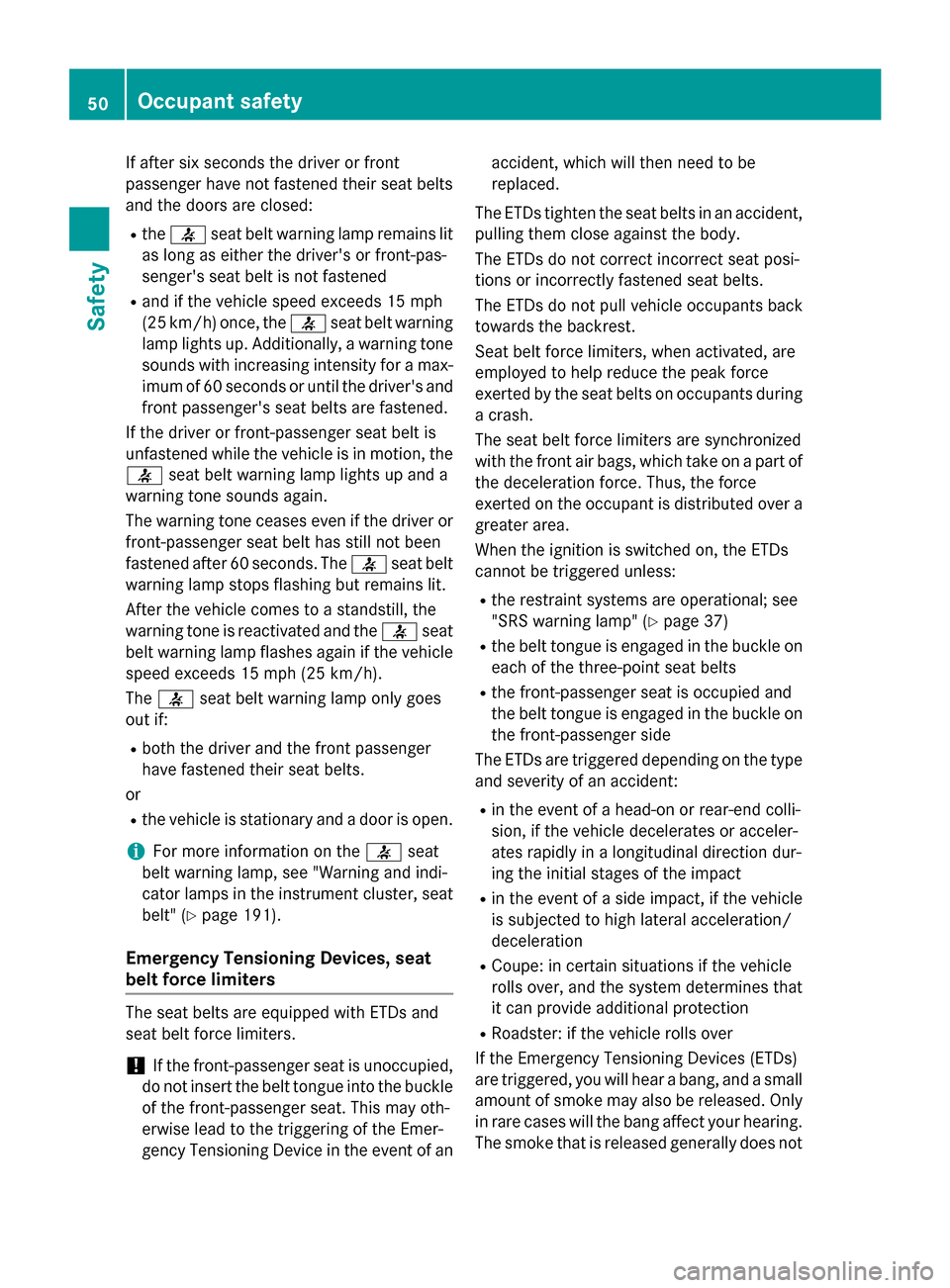
If after six seconds the driver or front
passenger have not fastened their seat belts
and the doors are closed:
R the 0076 seat belt warning lamp remains lit
as long as either the driver's or front-pas-
senger's seat belt is not fastened
R and if the vehicle speed exceeds 15 mph
(25 km/h )once, the 0076seat belt warning
lamp lights up. Additionally, awarning tone
sounds with increasing intensity for amax-
imum of 60 seconds or until the driver's and
front passenger's seat belts are fastened.
If the driver or front-passenger seat belt is
unfastened whilet he vehicle is in motion, the
0076 seat belt warning lamp lights up and a
warning tone sounds again.
The warning tone ceases even if the driver or
front-passenger seat belt has still not been
fastened after 60 seconds. The 0076seat belt
warning lamp stops flashing but remains lit.
After the vehicle comes to astandstill ,the
warning tone is reactivated and the 0076seat
belt warning lamp flashes again if the vehicle
speed exceeds 15 mph (25 km/h).
The 0076 seat belt warning lamp only goes
out if:
R both the driver and the front passenger
have fastened their seat belts.
or
R the vehicle is stationary and adoor is open.
i For more information on the
0076seat
belt warning lamp,s ee "Warning and indi-
cator lampsint he instrument cluster, seat
belt" (Y page 191).
Emergency Tensioning Devices, seat
beltf orce limiters The seat belts are equippedw
ith ETDs and
seat belt force limiters.
! If the front-passenger seat is unoccupied,
do not insert the belt tongue into the buckle of the front-passenger seat. This may oth-
erwisel eadtot he triggering of the Emer-
gency Tensioning Device in the event of an accident, which willt
hen need to be
replaced.
The ETDs tighten the seat belts in an accident,
pulling them close against the body.
The ETDs do not correct incorrect seat posi-
tions or incorrectly fastened seat belts.
The ETDs do not pullv ehicle occupants back
towards the backrest.
Seat belt force limiters, when activated, are
employed to help reduce the peak force
exerted by the seat belts on occupants during ac rash.
The seat belt force limiters are synchronized
with the front air bags,w hich take onapart of
the deceleration force. Thus, the force
exerted on the occupant is distributed over a
greater area.
When the ignition is switched on, the ETDs
cannot be triggered unless:
R the restraint systems are operational; see
"SRS warning lamp"( Ypage 37)
R the belt tongue is engage dinthe buckle on
each of the three-point seat belts
R the front-passenger seat is occupie dand
the belt tongue is engage dinthe buckle on
the front-passenger side
The ETDs are triggered depending on the type
and severity of an accident:
R in the event of ahead-on or rear-end colli-
sion, if the vehicle decelerates or acceler-
ates rapidly in alongitudinal direction dur-
ing the initial stages of the impact
R in the event of aside impact, if the vehicle
is subjected to high latera lacceleration/
deceleration
R Coupe: in certain situations if the vehicle
rolls over, and the system determines that
it can provide additional protection
R Roadster: if the vehicle rolls over
If the Emergency Tensioning Devices (ETDs)
are triggered, you willh earabang, and asmall
amount of smoke may also be released. Only
in rare cases willt he bang affect yourh earing.
The smoke that is released generally does not 50
Occupant safetySafety
Page 53 of 290
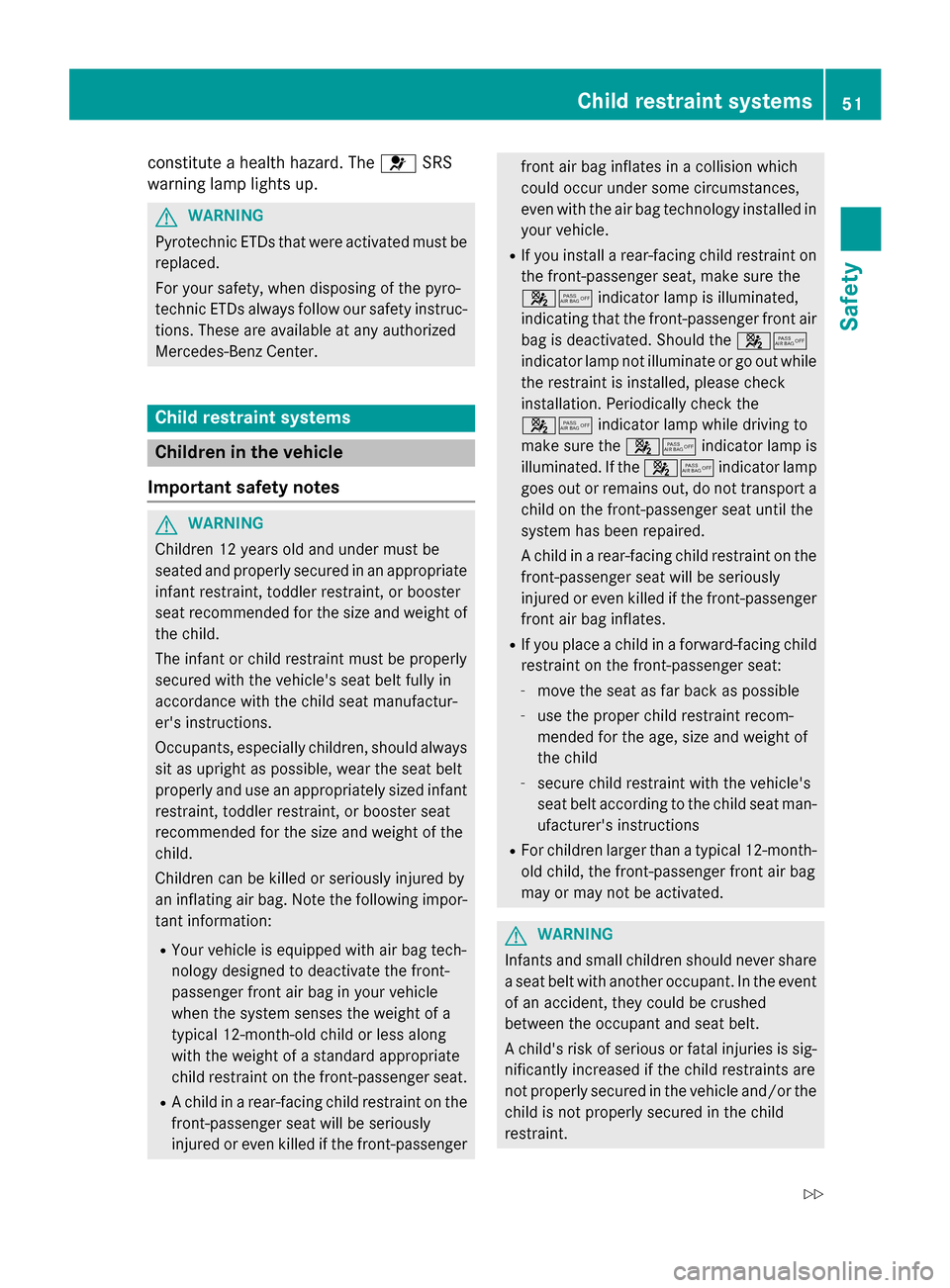
constitute
ahealth hazard .The 0075 SRS
warning lamp lights up. G
WARNING
Pyrotechnic ETDs that were activate dmustbe
replaced.
For your safety ,whend isposing of the pyro-
techni cETDs always follow ou rsafety instruc-
tions .These are available at any authorized
Mercedes-Benz Center. Child restraint systems
Childre
ninthe vehicle
Important safety notes G
WARNING
Childre n12years old and under mus tbe
seated and properly secured in an appropriate
infant restraint, toddle rrestraint, or booster
sea trecommended for the size and weigh tof
the child.
The infant or chil drestraint mus tbep roperly
secured with the vehicle's sea tbeltf ully in
accordance with the chil dseatm anufactur-
er's instructions.
Occupants, especially children, shoul dalways
sit as upright as possible ,wearthe sea tbelt
properly and us eanappropriately size dinfant
restraint, toddle rrestraint, or booster seat
recommended for the size and weigh tofthe
child.
Childre ncan be kille dorseriously injured by
an inflating ai rbag.N ote the following impor-
tant information:
R You rvehicle is equipped with ai rbag tech-
nology designe dtodeactivate the front-
passenger front ai rbag in your vehicle
whe nthe system senses the weigh tofa
typica l12-month-old chil dorlessa long
with the weigh tofastandard appropriate
chil drestraint on the front-passenger seat.
R Ac hildinar ear-facing chil drestraint on the
front-passenger sea twillbes eriously
injured or eve nkilledift he front-passenger front ai
rbag inflate sinac ollision which
could occu runder some circumstances,
eve nwitht he ai rbag technolog yinstalled in
your vehicle.
R If yo uinstall arear-facing chil drestraint on
the front-passenger seat, make sure the
00730074 indicator lamp is illuminated,
indicating that the front-passenger front air ba gisd eactivated. Should the 00730074
indicator lamp not illuminate or go ou twhile
the restraint is installed, please check
installation. Periodicall ycheck the
00730074 indicator lamp while driving to
make sure the 00730074indicator lamp is
illuminated. If the 00730074indicator lamp
goe soutor remains out, do not transpor ta
chil dont he front-passenger sea tuntilthe
system ha sbeenr epaired.
Ac hildinar ear-facing chil drestraint on the
front-passenger sea twillbes eriously
injured or eve nkilledift he front-passenger
front ai rbag inflates.
R If yo uplace achildinaf orward-facing child
restraint on the front-passenger seat:
- move the sea tasfar back as possible
- uset he proper chil drestraint recom-
mended for the age, size and weigh tof
the child
- secure chil drestraint with the vehicle's
sea tbelta ccording to the chil dseatm an-
ufacturer's instructions
R For childre nlarge rthan atypica l12-month-
old child, the front-passenger front ai rbag
may or may not be activated. G
WARNING
Infants and small childre nshoul dneve rshare
as eatb eltw itha nother occupant. In the event
of an accident, they could be crushed
between the occupant and sea tbelt.
Ac hild's ris kofseriousorfatalinjurie sissig-
nificantl yincreased if the chil drestraints are
not properly secured in the vehicle and/or the chil disn ot properly secured in the child
restraint. Child restraint systems
51Safety
Z
Page 57 of 290
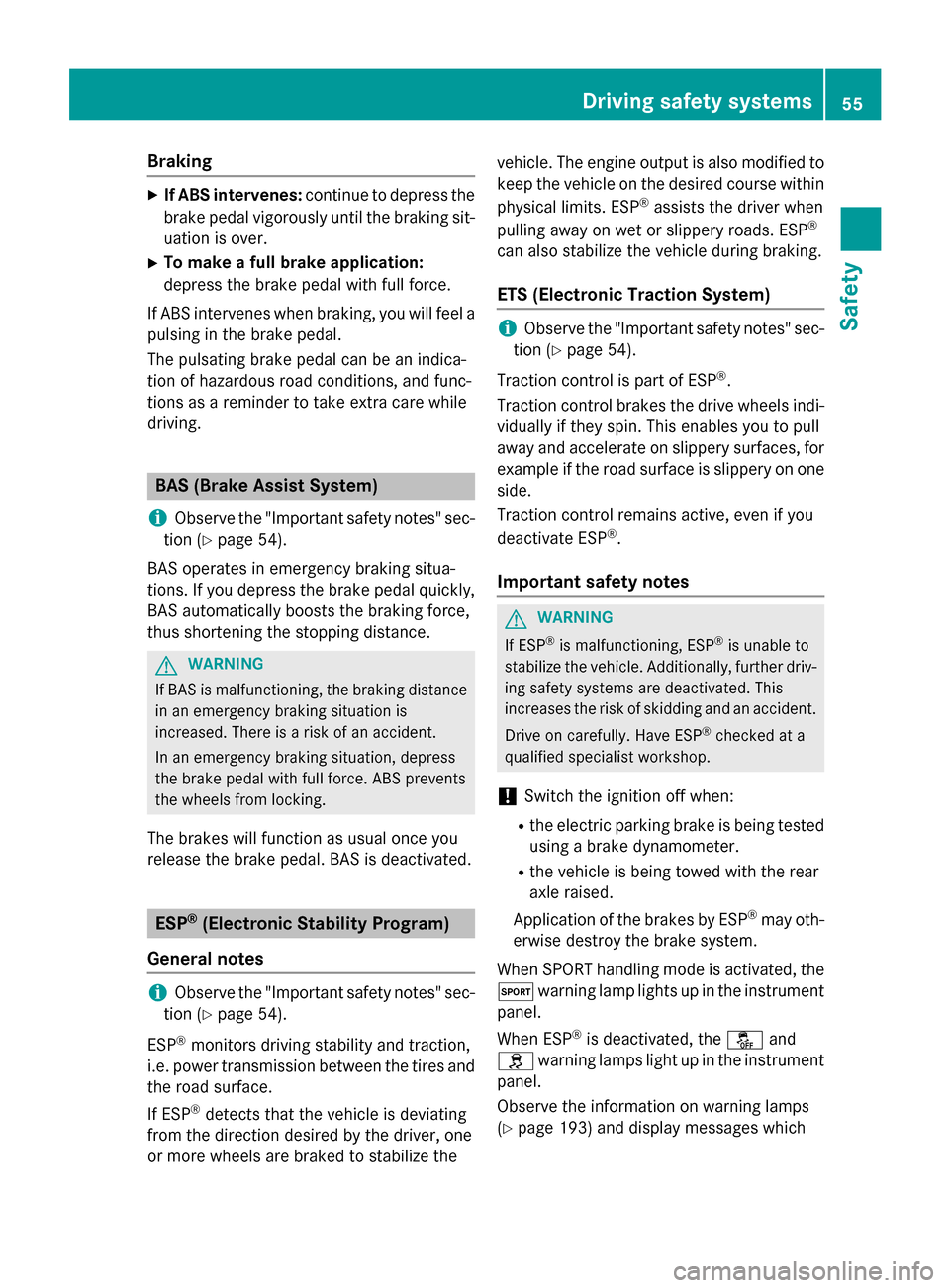
Braking
X
If ABS intervenes: continue to depress the
brake peda lvigorously unti lthe braking sit-
uatio niso ver.
X To make afullb rake application:
depress the brake peda lwithf ullf orce.
If ABS intervenes when braking ,you will fee la
pulsing in the brake pedal.
The pulsating brake peda lcan be an indica-
tio nofh azardou sroadc onditions, and func-
tions as areminder to take extra car ewhile
driving. BAS (Brak
eAssis tSystem)
i Observ
ethe "Important safety notes "sec-
tio n(Ypage 54).
BAS operates in emergency braking situa-
tions. If yo udepress the brake peda lquickly,
BAS automaticall yboosts the braking force,
thu sshortening the stopping distance. G
WARNING
If BAS is malfunctioning ,the braking distance
in an emergency braking situatio nis
increased .There is ariskofana ccident.
In an emergency braking situation, depress
the brake peda lwithf ullf orce. ABS prevents
the wheels from locking.
The brakes will functio nasusual once you
release the brake pedal. BAS is deactivated. ESP
®
(Electroni cStability Program)
General notes i
Observ
ethe "Important safety notes "sec-
tio n(Ypage 54).
ESP ®
monitors driving stability and traction,
i.e .power transmission between the tire sand
the roa dsurface.
If ESP ®
detects tha tthe vehicl eisdeviating
from the direction desired by the driver ,one
or more wheels ar ebraked to stabilize the vehicle. The engine outpu
tisa lsom odified to
kee pthe vehicl eonthe desired course within
physical limits .ESP ®
assists the driver when
pulling away on we torslipper yroads. ESP ®
can also stabilize the vehicl eduring braking.
ETS (Electroni cTraction System) i
Observ
ethe "Important safety notes "sec-
tio n(Ypage 54).
Tractio ncontro lispartofE SP®
.
Tractio ncontro lbrakes the drive wheels indi-
viduall yifthey spin. Thi senables yo utopull
away and accelerate on slippery surfaces, for
exampl eifthe roa dsurface is slippery on one
side.
Tractio ncontro lremains active, eve nifyou
deactivate ESP ®
.
Important safety notes G
WARNING
If ESP ®
is malfunctioning ,ESP ®
is unabl eto
stabilize the vehicle. Additionally, further driv- ing safety system sare deactivated. This
increases the ris kofskidding and an accident.
Driv eonc arefully. Hav eESP®
checked at a
qualified specialist workshop.
! Switch the ignition off when:
R the electri cparking brake is being tested
using abrake dynamometer.
R the vehicl eisbeing towed with the rear
axl eraised.
Application of the brakes by ESP ®
ma yoth-
erwis edestro ythe brake system.
Whe nSPOR Thandling mod eisactivated ,the
0074 warning lamp lights up in the instrument
panel.
Whe nESP®
is deactivated ,the 00BB and
0089 warning lamps light up in the instrument
panel.
Observ ethe informatio nonwarning lamps
(Y page 193 )and display messages which Driving safety systems
55Safety Z
Page 58 of 290
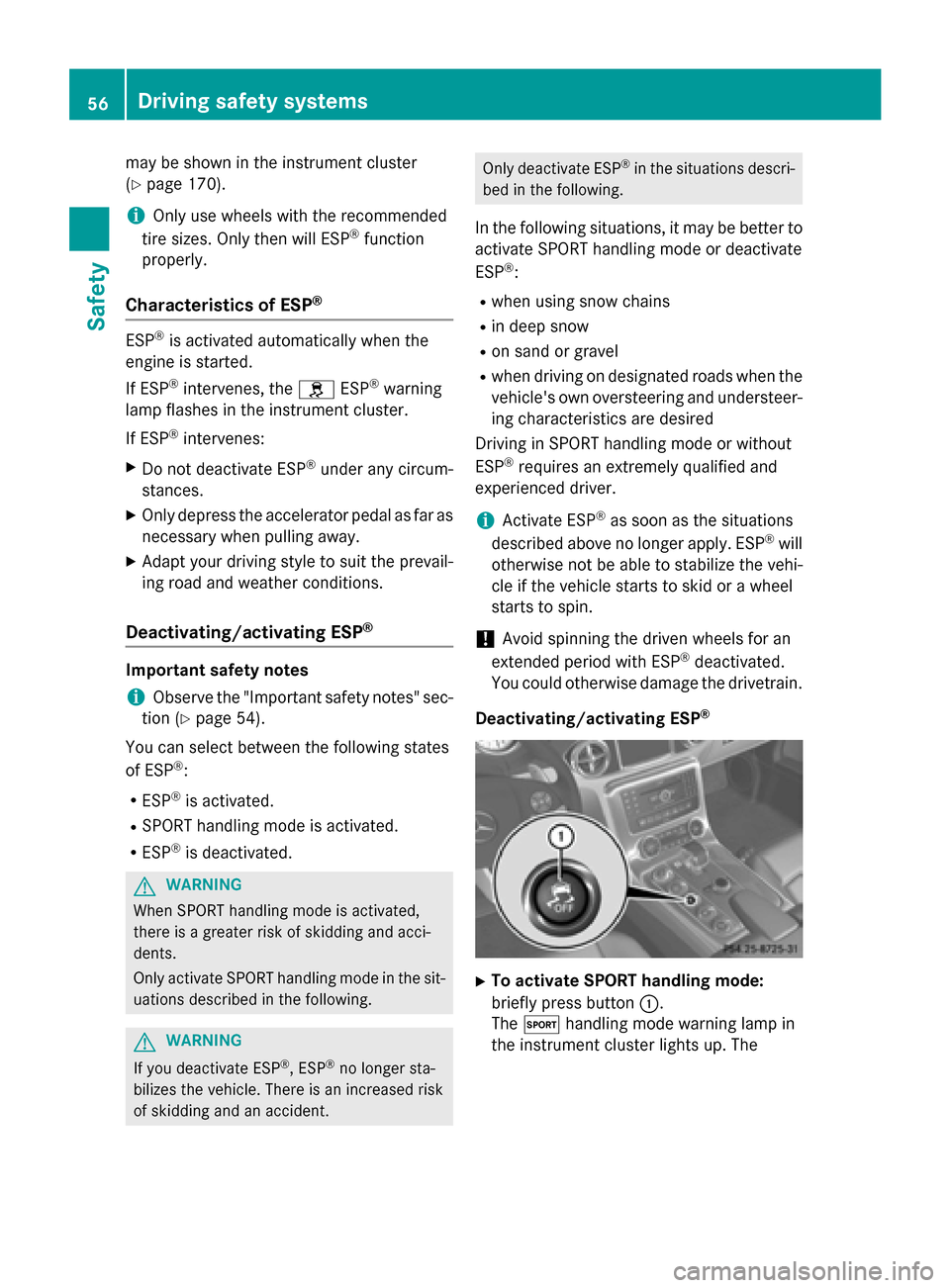
may be show
ninthe instrument cluster
(Y page1 70).
i Only use wheels with the recommended
tire sizes. Only then willE SP®
function
properly.
Characteristics of ESP ®ESP
®
is activated automatically when the
engine is started.
If ESP ®
intervenes, the 0089ESP®
warning
lamp flashes in the instrument cluster.
If ESP ®
intervenes:
X Do not deactivate ESP ®
under any circum-
stances.
X Only depress the accelerator peda lasfar as
necessary when pulling away.
X Adapt yourd riving style to suitt he prevail-
ing road and weather conditions.
Deactivating/activating ESP ®Important safety notes
i Observe the "Important safety notes" sec-
tion (Y page54).
You can select between the following states
of ESP ®
:
R ESP ®
is activated.
R SPORT handling mode is activated.
R ESP ®
is deactivated. G
WARNING
When SPORT handling mode is activated,
there is agreater risk of skidding and acci-
dents.
Only activate SPORT handling mode in the sit- uations described in the following. G
WARNING
If you deactivate ESP ®
,E SP ®
no longer sta-
bilizes the vehicle. There is an increase drisk
of skidding and an accident. Only deactivate ESP
®
in the situations descri-
bed in the following.
In the following situations, it may be better to activate SPORT handling mode or deactivate
ESP ®
:
R when using snow chains
R in deep snow
R on sand or gravel
R when driving on designated road swhen the
vehicle's own oversteering and understeer-
ing characteristics are desired
Driving in SPORT handling mode or without
ESP ®
requires an extremely qualified and
experienced driver.
i Activate ESP ®
as soon as the situations
described above no longer apply.E SP®
will
otherwise not be abletos tabilize the vehi-
cle if the vehicl estarts to skid or awheel
starts to spin.
! Avoid spinning the driven wheels for an
extended perio dwith ESP ®
deactivated.
You could otherwise damage the drivetrain.
Deactivating/activating ESP ® X
To activate SPORT handlin gmode:
briefl ypress button 0043.
The 0074 handling mode warning lamp in
the instrument cluster lights up. The 56
Driving safety systemsSafety
Page 59 of 290
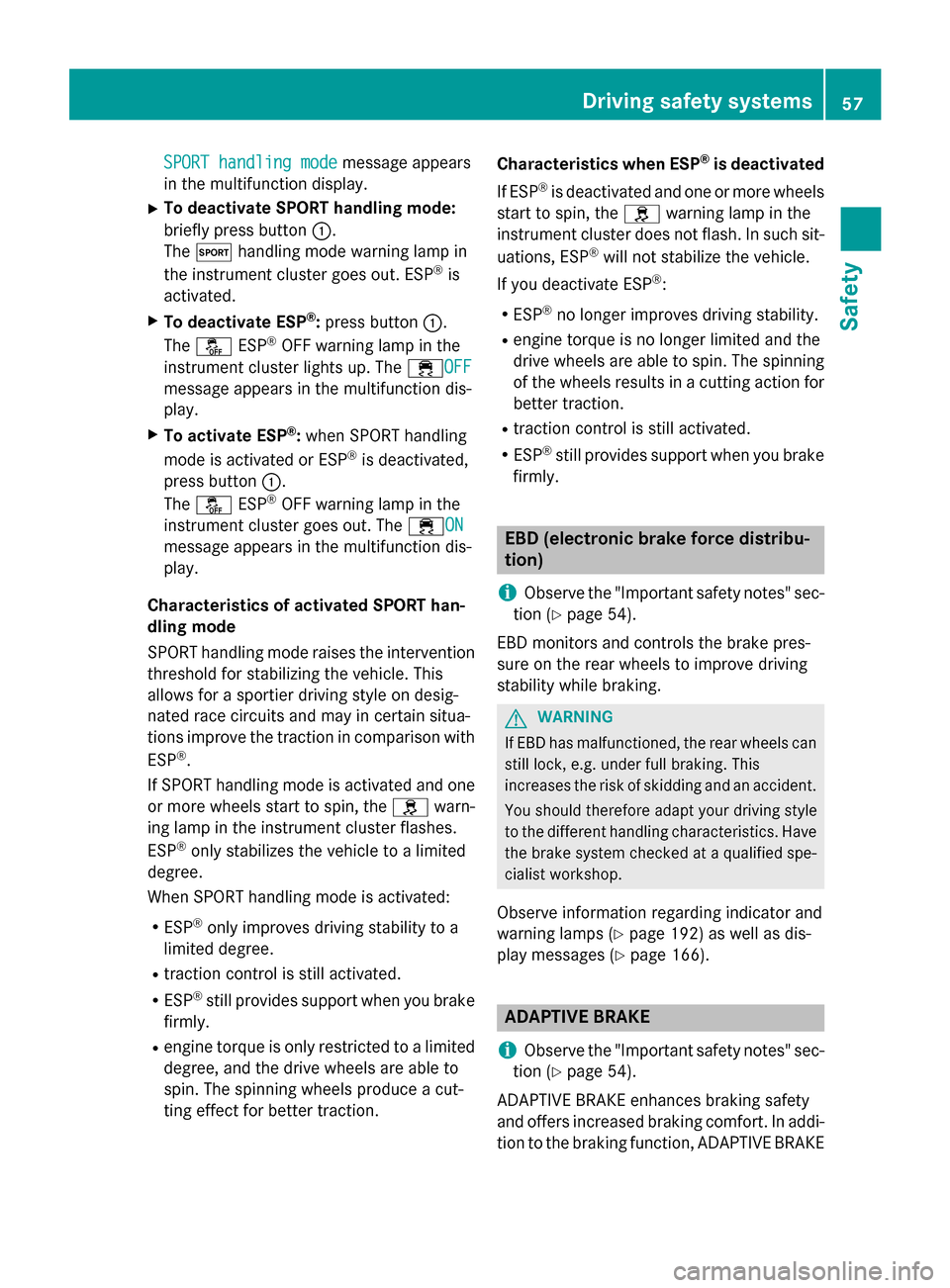
SPORT handling mode
SPORT handling mode
message appears
in the multifunction display.
X To deactivate SPORT handling mode:
briefly press button 0043.
The 0074 handling mode warning lamp in
the instrument cluster goes out. ESP ®
is
activated.
X To deactivate ESP ®
:press button 0043.
The 00BB ESP®
OFF warning lamp in the
instrument cluster lights up. The 00E5OFFOFF
message appears in the multifunction dis-
play.
X To activate ESP ®
:when SPORT handling
mode is activated or ESP ®
is deactivated,
press button 0043.
The 00BB ESP®
OFF warning lamp in the
instrument cluster goes out. The 00E5ONON
message appears in the multifunction dis-
play.
Characteristics of activated SPORT han-
dling mode
SPORT handling mode raises the intervention threshold for stabilizing the vehicle. This
allows for asportier driving style on desig-
nated race circuits and may in certain situa-
tions improve the traction in comparison with
ESP ®
.
If SPORT handling mode is activated and one or more wheels start to spin, the 0089warn-
ing lamp in the instrument cluster flashes.
ESP ®
only stabilizes the vehicle to alimited
degree.
When SPORT handling mode is activated:
R ESP ®
only improves driving stability to a
limited degree.
R traction control is still activated.
R ESP ®
still provides support when you brake
firmly.
R engine torque is only restricted to alimited
degree, and the drive wheels are able to
spin. The spinning wheels produce acut-
ting effect for better traction. Characteristics when ESP
®
is deactivated
If ESP ®
is deactivated and one or more wheels
start to spin, the 0089warning lamp in the
instrument cluster does not flash. In such sit-
uations, ESP ®
will not stabilize the vehicle.
If you deactivate ESP ®
:
R ESP ®
no longer improves driving stability.
R engine torque is no longer limited and the
drive wheels are able to spin. The spinning
of the wheels results in acutting action for
better traction.
R traction control is still activated.
R ESP ®
still provides support when you brake
firmly. EBD (electronic brake force distribu-
tion)
i Observe the "Important safety notes" sec-
tion (Y page 54).
EBD monitors and controls the brake pres-
sure on the rear wheels to improve driving
stability while braking. G
WARNING
If EBD has malfunctioned, the rear wheels can still lock, e.g. under full braking. This
increases the risk of skidding and an accident.
You should therefore adapty our driving style
to the different handling characteristics. Have the brake system checked at aqualified spe-
cialist workshop.
Observe information regarding indicator and
warning lamps (Y page 192) as well as dis-
play messages (Y page 166). ADAPTIVE BRAKE
i Observe the "Important safety notes" sec-
tion (Y page 54).
ADAPTIVE BRAKE enhances braking safety
and offers increased braking comfort.Ina ddi-
tion to the braking function, ADAPTIVE BRAKE Driving safety systems
57Safety Z
Page 61 of 290
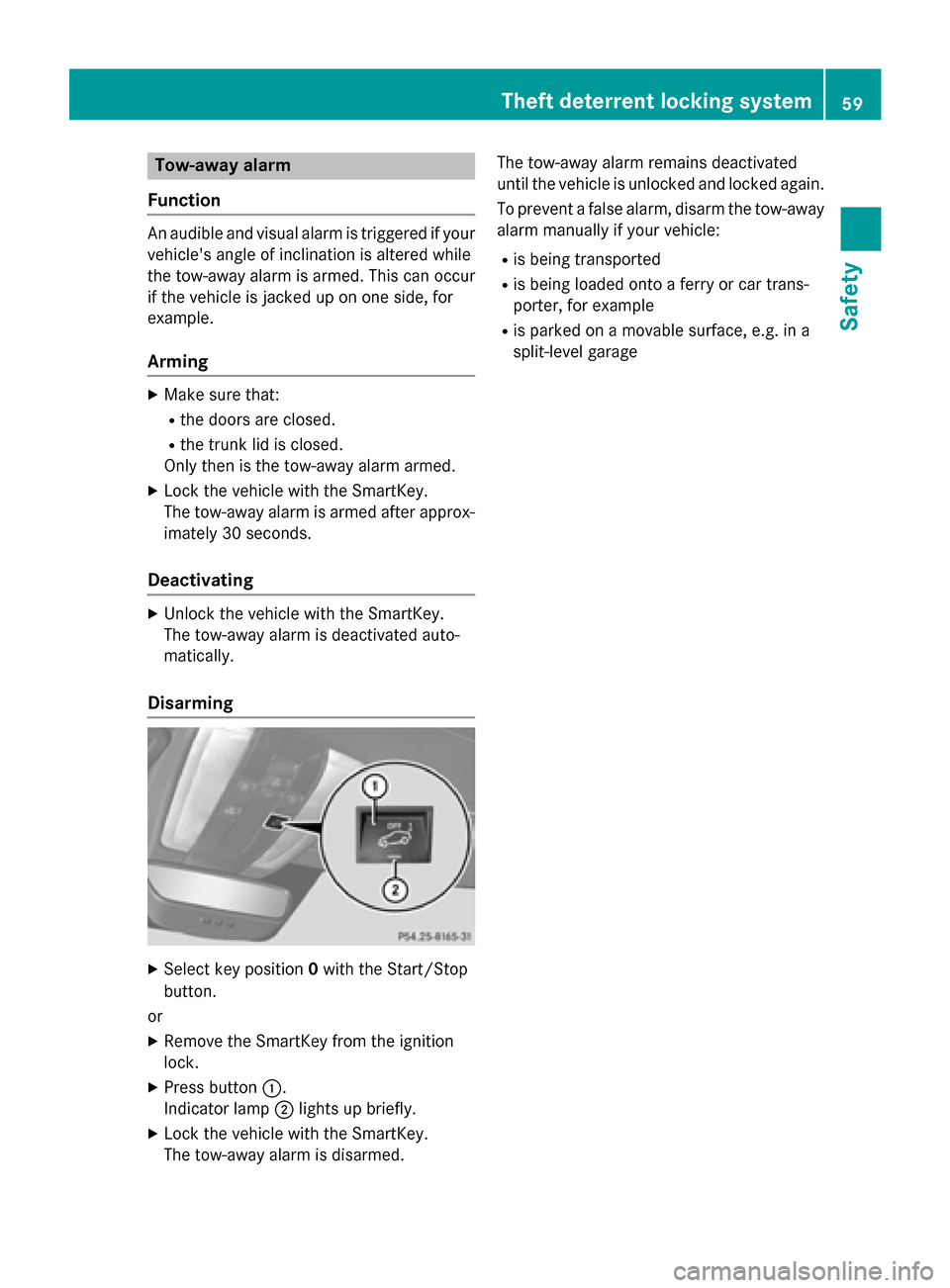
Tow-away alarm
Function An audibl
eand visua lalarm is triggered if your
vehicle's angle of inclinatio nisa ltere dw hile
the tow-away alar misarmed.Thisc an occur
if the vehicl eisjacke dupono ne side,for
example.
Arming X
Make sure that:
R the doors ar eclosed.
R the trunk li disclosed.
Onl ythen is the tow-away alar marmed.
X Lock the vehicl ewitht he SmartKey.
The tow-away alar misarmed after approx-
imatel y30seconds.
Deactivating X
Unlock the vehicl ewitht he SmartKey.
The tow-away alar misdeactivated auto-
matically.
Disarming X
Select key position 0with the Start/Stop
button.
or X Remov ethe SmartKe yfromt he ignition
lock.
X Press button 0043.
Indicato rlamp 0044lights up briefly.
X Lock the vehicl ewitht he SmartKey.
The tow-away alar misdisarmed. The tow-away alar
mremains deactivated
unti lthe vehicl eisunlocke dand locked again.
To prevent afalse alarm, disarm the tow-away
alar mm anuall yify ourv ehicle:
R is being transported
R is being loaded onto aferry or car trans-
porter ,for example
R is parked on amovable surface, e.g .ina
split-level garage Thef
tdeterren tlocking system
59Safety Z